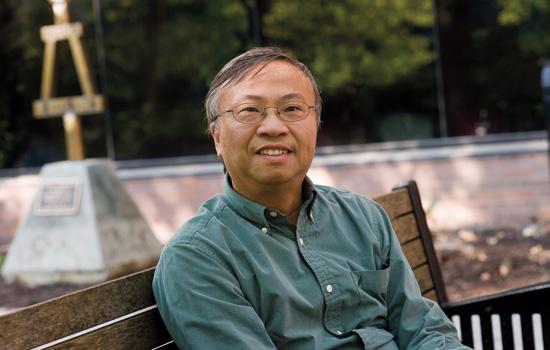Small chips, big impact
Microelectronic engineering celebrates 30 years
A. Sue Weisler
Patrick Chan ’10 entered RIT’s microelectronic engineering program to become part of one of the country’s fastest growing industries. He now joins more than 1,000 alumni in the field.
The smaller the computer chip, the larger the network of RIT graduates developing the powerhouse devices.
More than 1,000 RIT microelectronic engineering alumni are working in prominent semiconductor companies on the smallest of chips being incorporated in products from cars and computers to mobile phones and medical equipment.
Shortly after graduating from RIT’s program, Patrick Chan ’10 became one of those hires. The former electrical engineer from Eastman Kodak Co. was among a group of employees whose positions were eliminated, so he began looking for a new career path.
After classes and a co-op at Johns Hopkins Applied Physics Laboratory, he was recruited by Tokyo Electron Ltd., where he is an etch systems process engineer at the company’s site in Malta, N.Y. He provides the quality control and improvements for the equipment being built for computer chip manufacturers. “I felt microelectronics is more of an extension of my electrical engineering experience,” Chan says.
He is now part of one of the country’s fastest growing industries, a promising model for economic development in New York state and the U.S.
Microelectronic engineering at RIT celebrates 30 years in January. Since the program began in 1982, microelectronic engineering graduates have been placed in companies that are synonymous with the semiconductor industry: Texas Instruments, Intel, IBM, Micron and Samsung, for example.
Many are now in the managerial and executive ranks, says Robert Pearson, department head of microelectronic engineering. He adds that Chan’s supervisor in the Etch Process Group is Daniel Morvay, who received a bachelor’s degree in microelectronic engineering from RIT in 1991.
In its earliest years, the semiconductor industry was predominantly in research mode, but this has shifted to a balance between research on developing smaller but even more powerful chips, and toward manufacturing the millions of chips needed for a wide range of products, says Lynn Fuller ’70, ’73, professor of electrical and microelectronic engineering, who established RIT’s microelectronic engineering undergraduate program in 1982.
Fuller, a former department head, also built its graduate degree program and oversaw the construction of the department’s Semiconductor and Microsystems Fabrication Laboratory. “Now the need is for engineers to create the manufacturing processes that are used by these industries,” he says. “That’s where RIT comes in.”
RIT’s program is a known quantity in the industry, Fuller adds. While other universities have adapted coursework to cover semiconductor processes and development, often these are only electives within an electrical engineering program. It is at the graduate level that most universities concentrate their specific microelectronic programming. RIT’s undergraduates have classroom, cleanroom and co-op experiences giving them an edge, and it is an industry where demand outweighs supply.
“Companies look for students who understand the entire process. They may work in one specific area when they are hired, but they understand how it links up with all the other aspects of the process—from design to fabrication to test to manufacturing,” Fuller says.
A graduate’s career ladder may involve several years in the etching or lithography area followed by advancement to process integration engineers. The industry is not that old, he adds, with the first chips being used in the 1960s. “Granted there are a lot of changes. We have gone from things you can make in your kitchen to microchips that have 32 billion transistors,” he says. “But the job itself is still the same.”
Early prototypes had 2,000 transistors embedded; today, electronic signals are processed by more than 1 billion. Researchers continue to stretch and challenge that capacity. The future for the industry is in its development of new devices and use of a wider range of materials to develop the computer chips, says Fuller.
Chan had industry and corporate experience before coming to RIT. He used to design circuitry on printed circuit boards working as an electrical engineer at both Kodak and GCA Corp. Chan pursued graduate courses to acquire skills in the latest trends specific to the semiconductor industry.
“The amazing thing is, this industry encompasses many disciplines of the physical sciences,” Chan says. “I feel lucky to be a part of this technology even though I play a very small part in the big scheme of things.”










